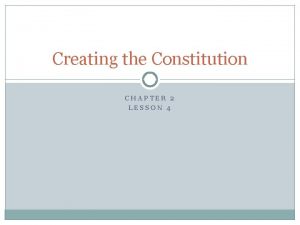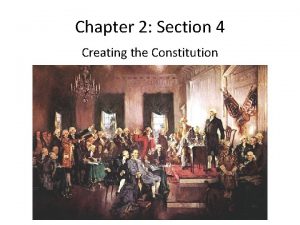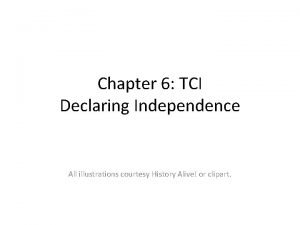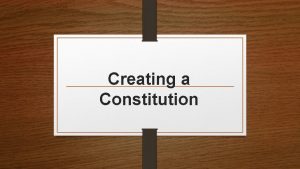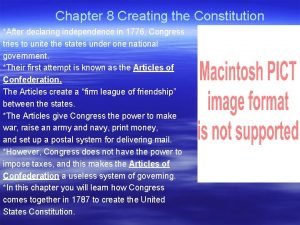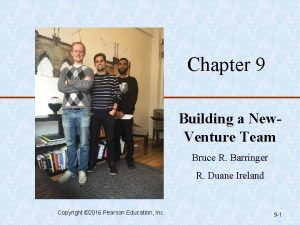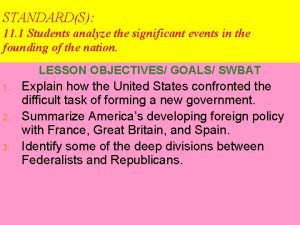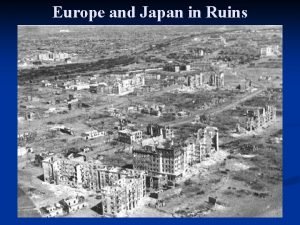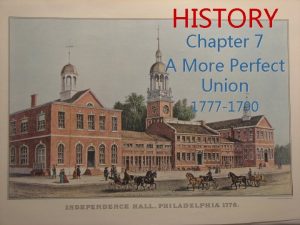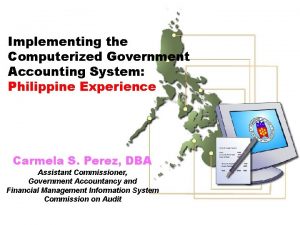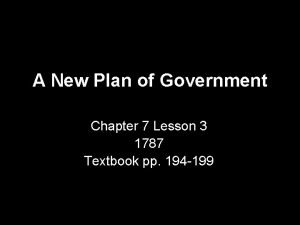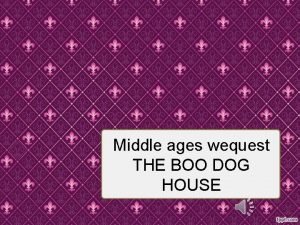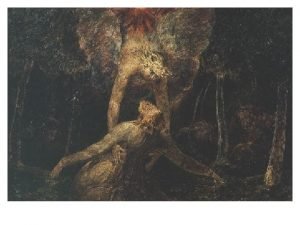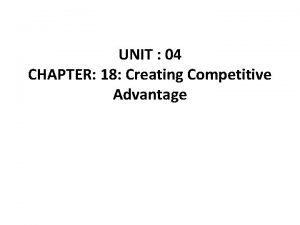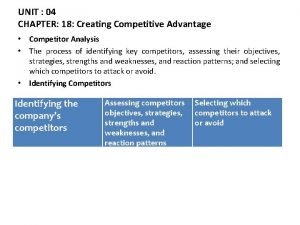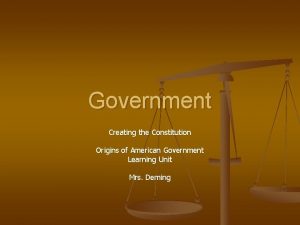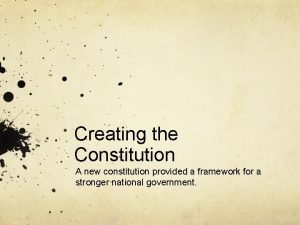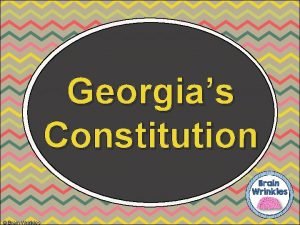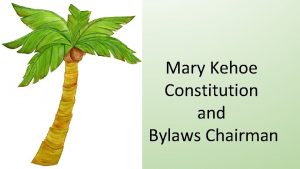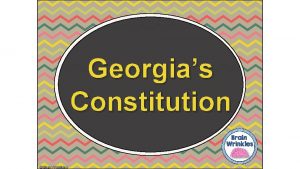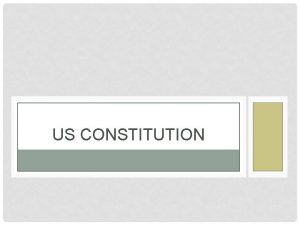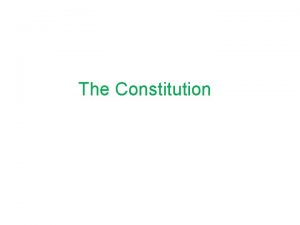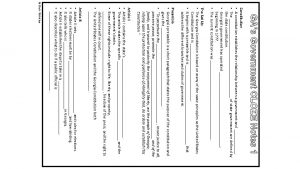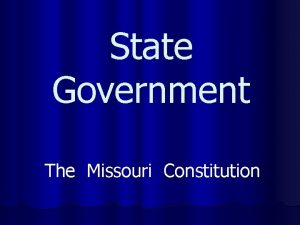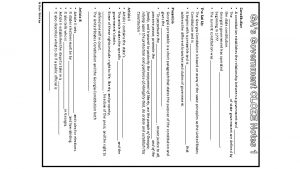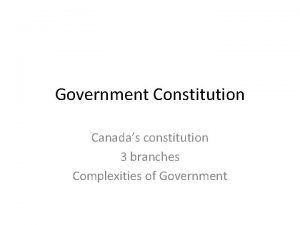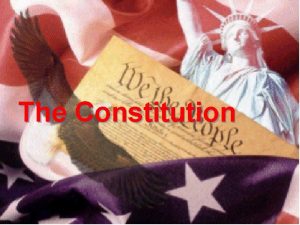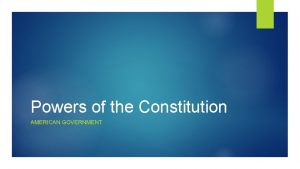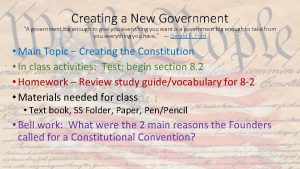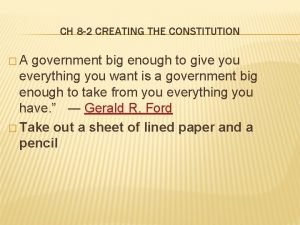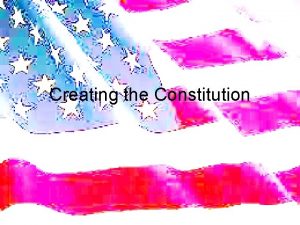Creating a New U S Constitution New Government























- Slides: 23

Creating a New U. S. Constitution New Government

Problems with the Articles of Confederation • The Articles of Confederation were purposefully designed to provide the people with as much power as possible. • After their recent history, they wanted to limit taxes. • This created a very weak central government and lead to many problems including: – Fighting over land sea rights – Lack of funds meant they could not maintain an Army or Navy and they could not build roads or canals – Difficulty passing laws

Constitutional Convention • The convention was held at Independence Hall in Philadelphia. There were 55 delegates in attendance, representing every state except Rhode Island. • The initial intention of the meeting was to simply revise the Articles of Confederation, but it resulted in an entirely new government and constitution.

Georgia in the Constitutional Convention • Georgia, and other Southern delegates, were unified in their relentless support of slavery. • This lead to: Three-Fifths Compromise- a compromise agreed upon by the North and the South which allowed for slaves to count toward a state’s overall population by counting slaves as “ 3/5 of a person. ”

Georgia in the Constitutional Convention • Georgian, Abraham Baldwin, is given credit for changing his vote to side with the “small states” in the Congressional representation debate. This decision evened the numbers for and against the Virginia Plan and allowed for the Great Compromise. The Great Compromise- created a bicameral legislature where each state had two members in the Senate but representation in the House of Representatives was based on the state’s population.

Abraham Baldwin • One of four Georgians at Constitutional Convention • Served FIVE terms as U. S. Congressman • Served TWO terms as U. S. Senator • Most famous for his role in the creation of the University of Georgia and served UGA’s first president.

William Few • He did not make a major impression at the Constitutional Congress • But- he later served as a senator, a representative, and a judge in the state of Georgia • In New York he became a member of the legislature and a bank president.

QUICK QUIZ! ARTICLES VS. CONSTITUTION

A) Created a president Articles, Constitution or Both? Both Articles Constitution Decide whether each statement applies to the Articles of Confederation, the Constitution, or both. A

B) Created a government Articles, Constitution or Both? Both Articles Constitution Decide whether each statement applies to the Articles of Confederation, the Constitution, or both. A B

Articles, Constitution or Both? C) Had one branch of government Both Articles Constitution Decide whether each statement applies to the Articles of Confederation, the Constitution, or both. A C B

Articles, Constitution or Both? D) Had enough power to do its job Both Articles Constitution Decide whether each statement applies to the Articles of Confederation, the Constitution, or both. A D C B

E) Created a court system Articles, Constitution or Both? Both Articles Constitution Decide whether each statement applies to the Articles of Confederation, the Constitution, or both. A C D B E

Articles, Constitution or Both? F) Gave large and small states the same power Both Articles Constitution Decide whether each statement applies to the Articles of Confederation, the Constitution, or both. A C D B E F

G) Created a Congress Articles, Constitution or Both? Both Articles Constitution Decide whether each statement applies to the Articles of Confederation, the Constitution, or both. A G B D E C F

Articles, Constitution or Both? H) Compromised between large and small states Both Constitution Decide whether each statement applies to the Articles of Confederation, the Constitution, or both. A H Articles G B D E C F

I) Created a military Articles, Constitution or Both? Both Constitution Decide whether each statement applies to the Articles of Confederation, the Constitution, or both. A H Articles I G B D E C F

Articles, Constitution or Both? I) Didn’t let Congress enforce its laws Both Constitution Decide whether each statement applies to the Articles of Confederation, the Constitution, or both. A H I G B D E Articles J C F

Changes to the New Constitution

Reading pages 174 -174 1. With the new constitution, the government was formed by THREE branches instead of ONE: legislative, executive, and judicial. 2. The legislative branch was now BICAMERAL instead of UNICAMERAL. They created the SENATE and the HOUSE OF REPRESENTATIVES. 3. With changing times and circumstances, the delegates provided for a method of amending, or making changes or additions, to the U. S. Constitution. 4. The first ten amendments made to the Constitution are known as the Bill of Rights. Video – School House Rock

Executive Branch Enforces the Laws Judicial Branch Interprets the Laws Supreme Court U. S. District Courts Special Courts (tax) President, Vice President, The Cabinet, Departments (Defense , Education) Legislative Branch Makes the Laws Bi Cameral -House of Reps (2) Senate (6) -Elected by the people

Checks and Balances • Checks and balances- the system that provides to each branch of government some power that controls or prevents some actions of the other two branches • Separation of Power- a division of responsibilities for government among the three branches (legislative, judicial, and executive) • Without checks and balances and separation of power, one person or portion of the government • This is the creation of an oligarchy, autocratic, or dictatorship.

na p ju poi sti nt ce Su sa p nd rem Ca n ju e de dg Co cid es ur t ei f co pr ns es tit id ut en io tia na l l act sa re y nc ge er em s all res d c ng an Co ills of s ob n t, et ssio en n v se sid rm Ca re nfi e P co ts. th and en ch tm ea eto oin mp a v app ni e Ca errid tive ov xecu e Ca Checks and Balances Can interpret constitutionality of laws. Can confirm or impeach judicial appointments, such as Supreme Court justices.
 Chapter 2 lesson 4 creating the constitution
Chapter 2 lesson 4 creating the constitution Chapter 2 section 4 creating the constitution
Chapter 2 section 4 creating the constitution Tci chapter 8 - creating the constitution answer key
Tci chapter 8 - creating the constitution answer key Creating the constitution vocabulary
Creating the constitution vocabulary Chapter 8 creating the constitution
Chapter 8 creating the constitution Texas constitution vs us constitution
Texas constitution vs us constitution Nc constitution vs us constitution
Nc constitution vs us constitution Constitution what is constitution
Constitution what is constitution Lesson 1 principles of the constitution
Lesson 1 principles of the constitution New-old approach to creating new ventures
New-old approach to creating new ventures Six principles of the constitution
Six principles of the constitution Flocabulary branches of government
Flocabulary branches of government State and federal constitutions
State and federal constitutions New venture team
New venture team Creating a new nation
Creating a new nation Three political problems postwar governments faced.
Three political problems postwar governments faced. Chapter 7 lesson 2 forging a new constitution
Chapter 7 lesson 2 forging a new constitution Philippine government accounting
Philippine government accounting Chapter 7 lesson 3 a new plan of government
Chapter 7 lesson 3 a new plan of government During the middle ages noblewomen had
During the middle ages noblewomen had Hierarchy chart of new france government
Hierarchy chart of new france government The elohim creating adam
The elohim creating adam Value creation strategy
Value creation strategy Chapter 18 creating competitive advantage
Chapter 18 creating competitive advantage
